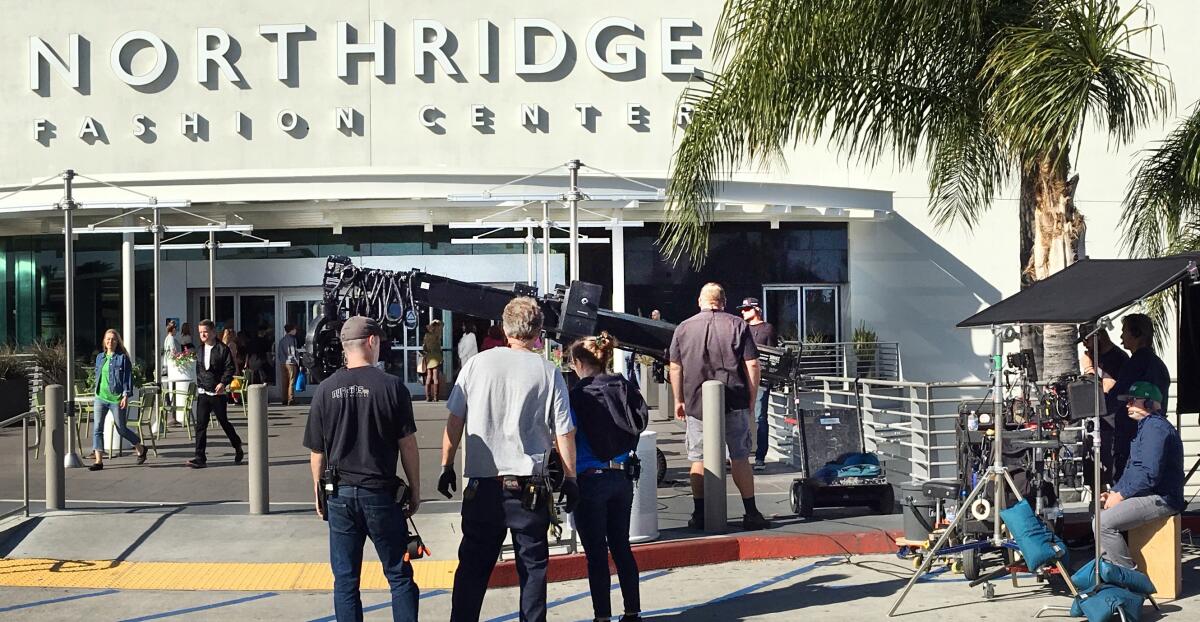Filming is booming, but some crews are leaving L.A. Blame a shortage of studio space

On a sprawling 20-acre campus at the former Unocal Center building in Westlake, film crews were busy re-creating 1930s Hollywood as a backdrop for the eagerly anticipated Netflix movie “Mank.”
The film, about screenwriter Herman Mankiewicz and his clashes with Orson Welles over the making of “Citizen Kane,” is one of the plethora of productions occupying Los Angeles Center Studios, which last year also hosted Eddie Murphy and the cast of the Golden Globe-nominated “Dolemite Is My Name” as well as the Netflix series “Glow.”
“If I had six more soundstages, I think we would have them all leased,” said Sam Nicassio, president of L.A. Center Studios, adding that the studio facility is already almost fully booked for 2020. “We have had to say ‘no’ a lot.”
Some are calling it the “space race.” Southern California continues to enjoy a boom in local production activity, thanks to the rise of Netflix and other streaming services that have invested heavily in original series and films. California’s film tax credit program also has lured some TV shows and lower-budget movies back to the state.
But the surge in demand has created a crunch for studio space, causing some producers to look outside L.A. for places to shoot.
FilmL.A. President Paul Audley recently cited the lack of studio space as one of the reasons for a surprising 6% drop in location filming last year in the city and county of Los Angeles.
“The unions tell us everybody is working, so it’s not ‘the sky is falling,’ but the truth of it is we could do more and do better and probably see those numbers crawl back up to the highest levels … if we had space,” Audley told The Times.
Greater Los Angeles has at least 334 certified soundstages and a combined 4.73 million square feet of production space. Counting spaces such as empty warehouses, which can house permanent sets for generic locations like hospitals and courtrooms, Greater L.A. has 5.7 million square feet of production space. That is nearly as much as California’s top five competitors — New York, Georgia, Louisiana and the Canadian provinces of Ontario and British Columbia — combined, according to FilmL.A.
The problem is that most of the certified production space in L.A. is at or near capacity. A study by FilmL.A., which handles film permits for the city and the county, found that the occupancy rate of soundstages in 2016 averaged 96%. That number is expected to be even higher in an updated report due out in the coming weeks.
To be sure, Atlanta, Albuquerque, N.M., and Vancouver, Canada, continue to attract film crews with steep tax credits. But the dearth of available studio space in L.A. means producers either have to leave the area to find certified soundstages or “compromise and go into a space that is open but is not designed for filming,” Audley said.
More than 1.5 million square feet of production space in Los Angeles County was leased in 2019, up from 780,000 square feet in 2011, according to real estate brokerage CBRE.
“It’s an unprecedented time,” said Craig Peters, a longtime industrial real estate broker at CBRE, who spends much of his time helping companies find production locations. “Time and time again we are seeing industrial buildings get converted into soundstages because all the operating soundstages are pretty much at 0% vacancy and they have got a line of guys waiting for them.”
Even a Costco in Canoga Park was used for shoots for “Captain Marvel” and “Top Chef Junior” through the end of 2018, according to FilmL.A.
There is some new construction of stages, but “almost before they can open the doors, people are taking out space and leasing it up to hold it for their future needs,” Audley said.
Los Angeles Center Studios had an occupancy rate of 107% last year and had to open on weekends to meet demand. Its rents have gone up 15% in the last five years, Nicassio said.
Driving the demand for space are tech companies-turned-content creators such as Netflix and Amazon. Content creators rented more than 4 million square feet of L.A. County office space in the last three years, according to CBRE.
As Netflix has outspent its peers on content, it also has snapped up office and production space across the city. Netflix has occupied, or agreed to move into, about 1.6 million square feet of space in the area.
The streaming giant also uses local stages such as Los Angeles Center Studios and Raleigh Studios and is still looking for more space for its productions, said a person with knowledge of the matter who was not authorized to speak publicly. To accommodate its pipeline, Netflix has expanded into New Mexico, acquiring a studio complex near Albuquerque.
Traditional studios also have been expanding. Warner Bros. recently broke ground on a major expansion of its Burbank headquarters. NBCUniversal is building a new 10-soundstage complex in Los Angeles.
Walt Disney Co. secured approval in 2013 to develop what would be one of the largest new studio developments in more than a decade, but it has yet to break ground at the 58-acre Golden Oak Ranch in the Santa Clarita Valley. Disney declined to comment. (The urgency to develop the site may have been lessened by Disney’s acquisition last year of the 20th Century Fox film studio and other assets.)
The studio expansions come during a period of massive investment in content. Last year, for the first time, the total number of scripted TV shows topped 500, doubling the number produced a decade ago, FX Networks Chairman John Landgraf said at the Television Critics Assn.’s winter press events last month.
“We are busier than we have ever been,” said Pam Elyea, whose North Hollywood-based props business, History for Hire, saw a 15% increase in revenue last year.
In Sun Valley, boutique studio and rental equipment company Line 204 has just started a 20-month build for a new 240,000-square-foot studio lot with 10 soundstages.
“I could be completely booked today,” Line 204 Chief Executive Alton Butler II said.
Quixote Studios cut the ribbon last year on a $30-million, 100,000-square-foot facility in Pacoima, and it is already full with clients, including Disney and Sony Pictures, said cofounder Jordan Kitaen. In nearby Sylmar, Quixote also is converting an 85,000-square-foot warehouse into a production facility set to open this spring.
Producers are willing to sign leases for three to four years instead of one year, Kitaen said.
Though he worries the new construction could create a glut of studio space, for now, Kitaen said, business is “as good as it’s ever been.”
Production is already experiencing bottlenecks because of the shortage of space locally, said one studio executive, who declined to be identified because he was not authorized to speak publicly.
To address the space crunch, county officials are in the early stages of trying to open up more locations for filming.
One such place could be the Art Deco-era L.A. County General Hospital, said Gary Smith, the county’s film and digital media liaison. Used as the backdrop for the ABC soap opera “General Hospital,” the 19-story building was largely abandoned in 2008, but the county is considering repurposing it for low-income housing and potentially for filming too, Smith said.
“There’s just no space,” he said. “This is a really important issue for us.”
The space crunch has created new opportunities for independent studios just outside the city. Santa Clarita Studios in January 2019 signed a new multiyear lease for a 175,000-square-foot building that was converted to soundstages. Home to the 1990s hit show “Melrose Place,” the production company now has 27 stages, 24 of which are booked out long-term, studio president Mike DeLorenzo said.
Filming has surged throughout the city of Santa Clarita, where this year’s Oscar-nominated “Once Upon a Time … in Hollywood” and “Ford v Ferrari” shot key scenes. The number of film permits Santa Clarita issued grew from 178 in 2003 to 576 last year, according to the city’s film office.
DeLorenzo said he’s the busiest he’s been in 40 years, though he worries about a possible writers strike this summer. “We are holding off on any expansion until we hear what happens with those negotiations,” he said.
More to Read
Inside the business of entertainment
The Wide Shot brings you news, analysis and insights on everything from streaming wars to production — and what it all means for the future.
You may occasionally receive promotional content from the Los Angeles Times.











